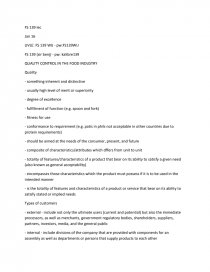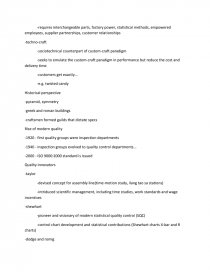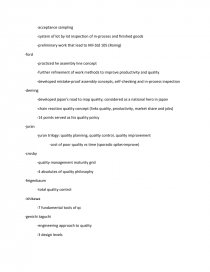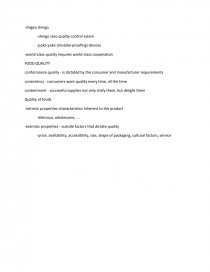Quality Control in the Food Industry
Essay by Shaira Erika Noelle • November 22, 2018 • Study Guide • 1,232 Words (5 Pages) • 1,218 Views
FS 139 lec
Jan 16
UVLE: FS 139 WIJ - pw:FS139WIJ
FS 139 (sir benj) - pw: kalibre139
QUALITY CONTROL IN THE FOOD INDUSTRY
Quality
- something inherent and distinctive
- usually high level of merit or superiority
- degree of excellence
- fulfillment of function (e.g. spoon and fork)
- fitness for use
- conformance to requirement (e.g. patis in phils not acceptable in other countries due to protein requirements)
- should be aimed at the needs of the consumer, present, and future
- composite of characteristics/attributes which dffers from unit to unit
- totality of features/characteristics of a product that bear on its ability to satisfy a given need (also known as general acceptability)
- encompasses those characteristics which the product must possess if it is to be used in the intended manner
- is the totality of features and characteristics of a product or service that bear on its ability to satisfy stated or implied needs
Types of customers
- external - include not only the ultimate users (current and potential) but also the immediate processors, as well as merchants, government regulatory bodies, shareholders, suppliers, partners, investors, media, and the general public
- internal - include divisions of the company that are provided with components for an assembly as well as departments or persons that supply products to each other
Types of products
- goods - cars, food
- software - a computer program, an instruction, a report
- service - banking, insurance, transportation, sensory, packaging, quality assurance
Components of quality
- product features
-manufacturing industries: performance, reliability, durability, serviceabiloty, aesthetics, availability and options and expandability, reputation
- service industries: accuracy, timeliness, friendliness and courtesy, anticipating customer needs, knowledge of server, appearance of facilities and personnel, reputation
- freedom from deficiencies
-manufacturing industries: product free of defects and errors at delivery, during use, and during servicing, all processes free of rework loops, redundancy, and other waste
-service industries: service free of errors during original and future service transactions, all processes free of rework loops, redundancy, and other waste
Types of quality
-design/redesign
-component attributes
-how well the product is designed to achieve its purpose
-depends on intrinsic parameters
-conformance
-extent the product achieve the requirements or specifications
-related to extrinsic properties
-determined by how food is processed, packed, stored, and handled
-performance
-result of...
Quality paradigms
-custom-craft
-customize exactly what the customer wants
-relatively expensive
-need skilled craftsperson
-mass production and sorting
-focus is in production rates
-customers are gained through ass advertising and hard selling
-product is defined with the customer in mind, but without direct customer involvement
-requires interchangeable parts, factory power, unskilled labor pool, large customer poop, hard-selling
-statistical quality control
-similar to the mass production and sorting paradigm except that more attention is given to production processes
-statistical process control and lot-by-lot sampling inspection
-results in far less scrap and rework
-requires interchangeable parts, factory power, unskilled labor pool, large customer pool, hard-selling, statistical methods
-e.g. ice cream: cold chain, quality-time, size of ice crystals, freeze-thaw
-total quality management
-involves employees, custonmers and suppliers in addition to mass production and statistical methods
-customer input in product definition and product evaluation are used to increase product performance
-supplier involvement in the TQM helps to produce better products and reduce waste
-focus on employee involvemnet for the purpose of continuous improvement
-requires interchangeable parts, factory power, statistical methods, empowered employees, supplier partnerships, customer relationships
-techno-craft
-sociotechnical counterpart of custom-craft paradigm
-seeks to emulate the custom-craft paradigm in performance but reduce the cost and delivery time
-customers get exactly...
...
...





